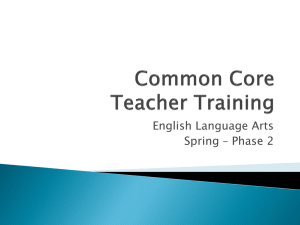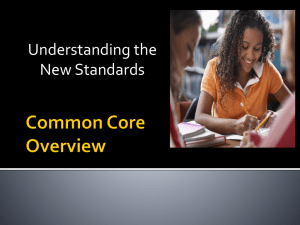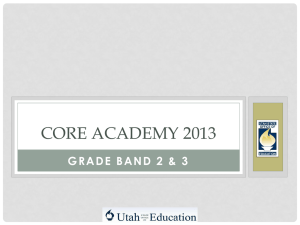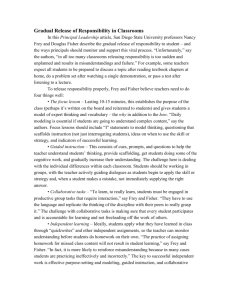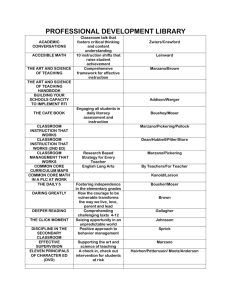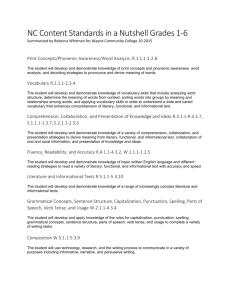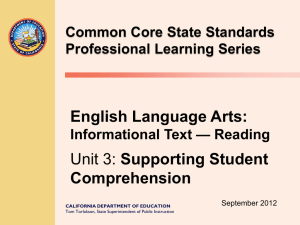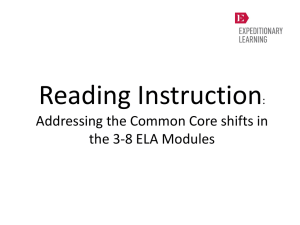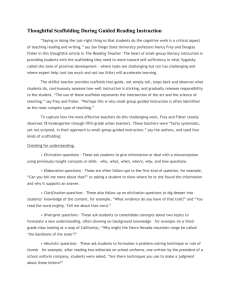Close Reading
advertisement
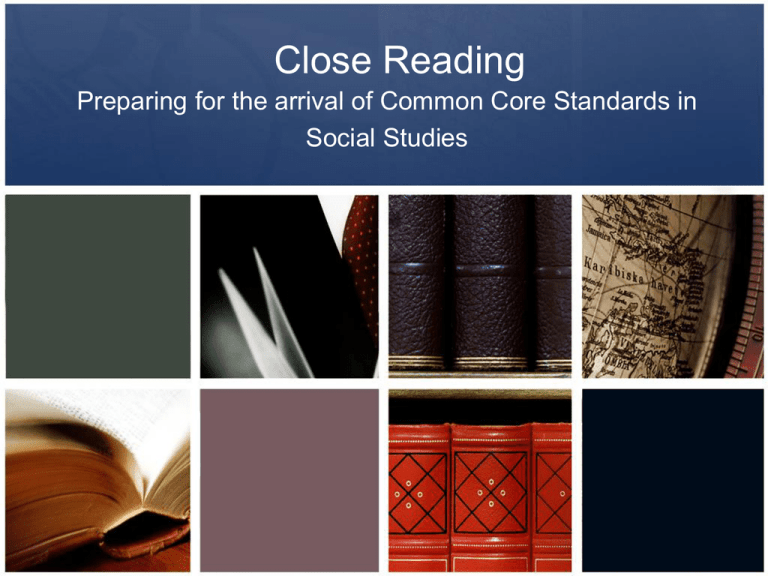
Close Reading Preparing for the arrival of Common Core Standards in Social Studies Common Standards • We are preparing our students to be college ready and literate. • The Common Core Standards will not replace Social Studies Standards. • We want our students to read, to write, to listen and to speak proficiently. Common Core Standards: Goals in Social Studies • We want our students to engage in – high quality literary text – informational text – thoughtful discussion of text • With the development of reading skills, our students will be able to improve content knowledge, reasoning skills and thoughtful citizens. What is Social Studies Role? • Grades 9th through 12th Grades, students will focus on 30% of literary text and 70% will be on informational text. • According to Tim Shanahan, Informational text provides information about the social or natural world, and deals with classes of objects and experiences rather than individual instances. What is Social Studies Role? • Social Studies teachers needs to assist English teachers in covering informational text. • The students will continue to be exposed to fiction, drama, and poetry in their English classes. • Social Studies classes and English classes must collaborate in selection of reading material. Role of Social Studies in Reading • According to Fisher, Frey and Lapp, teachers can assist in reading by comprehension, word solving, text structures and text features. • Social Studies teachers can help with visualizing, inferring, summarizing, predicting, questioning or monitoring. Common Core and Reading • Goal 1: students will be able to understand and clarify “unknown and multiple-meaning words and phrases by using context clues.” • Goal 2 : students will be able to analyze the text. • Goal 3: students will be able to provide evidence to support their opinions. Reading Questions We will need to teach our students how to read and to think about complex text! How do we achieve those skills? What is Close Reading? • It allows the reader to focus on details, patterns and meaning of the text. • Common Core Standards emphasize that students should be able to focus and to understand the text they are reading. (What is the author’s purpose?) Close Reading and our students • Students will be able to ponder thought provoking questions. • They will focus on vocabulary and how it influences the meaning of the text. • They will read the text closely Close Reading • According to Beers and Probst, we want the students to note, to think, to reread and to closely look at the text. Text Complexity: higher level thinking • The Common Core State Standards are the first to require text complexity as a specific standard: “Read and comprehend complex literary and informational texts independently and proficiently.” (CCRA.R.10) Factors associated with Text Complexity Vocabulary Academic and domain-specific terms Tier 2 vocabulary: high utility complex words that can be used in multiple contexts Syntax Coherence—Are the events and concepts logically connected and clearly explained? Unity—Do the ideas focus on the topic and not include irrelevant or distracting information? Audience appropriateness—Does the text match the background knowledge of the target reader? Factors associated with Text Complexity • Text structures Description of what is being read. Compare and Contrast Sequence of Events Cause and Effect Problem and Solution Text features -Headings/subheadings -Signal words -Graphs, pictures and captions Close Reading Characteristics • The text needs to be short. • The focus needs to be intense. • The text needs to lend itself to other parts of text. • The text should allow for exploratory discussion. • Students will reread the text. Students and Text-Dependent Questions • Find a short text for the students. • The class reads the text together. • Students will mark the text where they are confused or have questions about the text. • Students will reread the text- they try to understand the section they marked. Students and Text-Dependent Questions • The class shares the questions that they have about the text. • The students will pair-share their questions and answers. • As a class, the students will share their responses. • Students will continue to explore the text and continue to write their questions and answers. Types of Questions: General Understanding • What is the author claiming in the text? • What is the arc of the story? • What is the sequence of information? Types of Questions: Key Details • These questions can be based on important information that the author is conveying. • For example the five W’s can be used. – – – – – – Who was the key character ? What are the differences between events? Where does it state the reasons for the change? When did the event change the direction of the text? Why did the event occur? How did these events affect the change? • These questions are specific to key information. Types of Questions: Vocabulary & Text Structure • These types of questions help the students to focus on the organization of the text and word use. • These questions help students to understand how words convey feelings or ideas. • The use of word choice, figurative language, idioms and confusing words or phrases will help students understand the meaning of the text. Types of Questions: Purpose • Understanding the purpose of the text helps students to follow the flow of the text. • The questions guide the students to understand the purpose of the text. – – – – To inform To persuade To entertain To explain • In addition, students learn to understand bias and perspective the text. Types of Questions: Inference • Reading the text allows the students to see the whole picture. • If it is a persuasive essay, the students will search for its arguments. • If it is a informational text, they will search for key information. • If it is a literary text, they will probe for key details. Types of Questions: Opinions, Arguments and Intertextual Connections • These questions will be asked after the students have read the text several times. • The questions will ask the students their opinions but they must be able to defend them with evidence from the text. Progression of Text-Dependent Questions Whole Opinions, Arguments and Intertextual Connections Author’s Purpose Across Texts Entire Text Inferences Segments Paragraph Sentence Key Details Word Part General Understanding Source: Frey, N A Different Method of Thinking about Text-Dependent Questions • ANALYZE paragraphs on a sentence by sentence basis and sentences on a word by word basis to determine the role played by individual paragraphs, sentences, phrases, or words • INVESTIGATE how meaning can be altered by changing key words and why an author may have chosen one word over another • PROVE each argument in persuasive text, each idea in informational text, each key detail in literary text, and observe how these build to a whole A Different Method of Thinking about Text-Dependent Questions • EXAMINE how shifts in the direction of an argument or explanation are achieved and the impact of those shifts • QUESTION why authors choose to begin and end when they do • NOTE and ASSESS patterns of writing and what they achieve • CONSIDER what the text leaves uncertain or unstated At the end of the day, we want our students to do the following: Read Comprehend Revisit and Analyze the Text What we want for our students? • We want our students to be independent thinkers. • We want our students to have strong content knowledge. • We want our students to comprehend and to critique what they are reading. • We want our students to value evidence. Sources • Notice and Note by Kylene Beers and Robert E. Probst • Text Complexity by Douglas Fisher, Nancy Frey and Diane Lapp. • A Close Look at Close Reading by Beth Burke • Common core language arts in a PLC at work by Nancy Frey and Douglass Fisher • Text- Dependent Questions by Nancy Frey and Douglass Fisher
